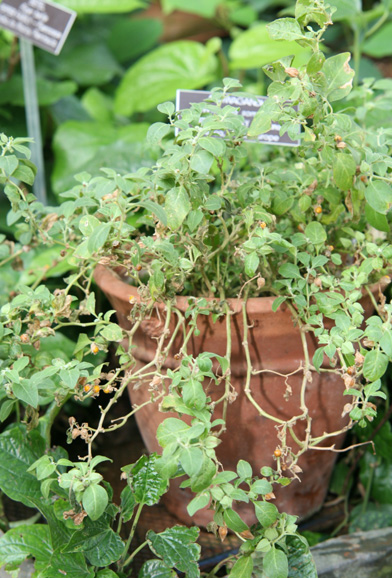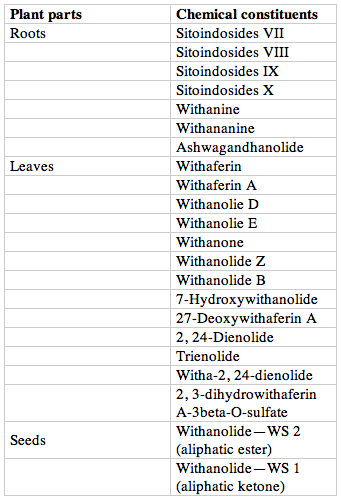Ashwagandha

Ashwagandha (Withania somnifera)
Photo: Cliff - lic. under CC-BY-2.0

Background & General Info
Ashwagandha (Withania somnifera) is a plant in the nightshade family (Solanaceae). This shrub is widely distributed across drier parts of India, Sri Lanka, Afghanistan, Pakistan, Sri Lanka and the Mediterranean regions, as well as at high altitudes up to 5,500 feet in the Himalayas. Throughout India, ashwagandha grows wildly, especially in hotter areas, on wastelands, and along roadsides, but it has also been cultivated in fields and open grounds as a late rainy season crop. [1][2] The nightshade family of plants to which Ashwagandha belongs also includes not only the famous (and famously poisonous) nightshades such as belladonna, but also many other notables such as the tomato, eggplant, mandrake and potato.
Ashwagandha is a small shrub growing to 75cm high, with small green flowers and fruit that is orange-red when ripe. The roots are long and tuberous and are used medicinally. It is the roots from which herbal supplements are generally made - although the leaves and fruit also have traditional herbal medicinal use as a topical treatment for tumors, carbuncles and ulcers. [1]
Ashwagandha is a member of the Solanaceae family and goes by its other common names, Indian ginseng or winter cherry. Ashwagandha literally translates to “smell of horse” - due to, firstly, the resemblance of the smell of the plant’s fresh roots to that of a horse and, secondly, the horse-like strength and vitality allegedly conferred by the consumption of this herb’s extracts according to commonly held belief. [3]
Ashwagandha - Botany
Ashwagandha is an evergreen, erect, branching, tomentose shrub that can be as tall as 30–150 cm. It’s simple, ovate, glabrous leaves can reach lengths of up to 10 cm, and its small flowers are greenish or lurid yellow, with about five flowers born together in axillary, umbellate cymes. The fruits are globose berries that turn orange red when mature, with yellow reniform seeds. When dry, the stout fleshy roots are cylindrical and gradually taper down. Externally, the roots appear brownish white but are creamy white in the interior when broken. They have a short and uneven fracture, a distinct strong odor, and a mucilaginous bitter and acrid taste. [2]
Ashwagandha - History & Traditional Use
In Ayurvedic traditional system of medicine, Ashwagandha holds a central and prominent role and is often dubbed the “royal herb” because of its numerous health-promoting and invigorating effects in different systems of the body, such as the neurological system, the immune system, the energy-production system, the endocrine system, and the reproductive system. [3] Ashwagandha is classified in Ayurveda as a rasayana; that is, it is strongly believed to improve both physical and mental health, boost body resistance against diseases, revitalize the body in debilitated conditions, and increase longevity. [4]
However despite its legendary status in the Orient, Ashwagandha seems to have been almost unmentioned in the West until relatively recent times. The earliest mention of the plant I can find in western literature is from Baden Powell's 1868 Hand-book of the economic products of the Punjab, Vol. 1 - and it is described as a narcotic used in fever treatment.
The name "somnifera" means "sleep bringer" which would indicate that it has sedative properties. Interestingly, another plant whose latin name is derived from the same root is the Opium-poppy: Papaver somniferum. "Ashwagandha Rasayana" is amusingly advertised in the Calcutta Review of 1927 as "An Investment For Overworked Brain and Nervous Debility", further indicating use as a calmative. [5]

Ashwagandha - Herbal Uses
Not only the Ayurvedic classical texts but also animal studies and clinical studies classify ashwagandha as an efficacious and safe adaptogen that can aid the body in combating stress. [3] Several formulations used to relieve musculoskeletal conditions such as arthritis and rheumatism incorporate this herb as a component, and ashwagandha in general has been celebrated as a tonic that invigorates, enhances overall health, prolongs lifespan, and prevents diseases in athletes, the elderly, and pregnant women. [6] Ashwagandha is also employed to help counteract chronic fatigue, weakness, dehydration, weakness of bones and loose teeth, impotence, premature aging, emaciation, debility, and muscle tension. The bitter leaves of this herb can be used as an anthelmintic, and an infusion concocted from them serves as a remedy for fever. The bruised leaves and fruits are locally applied on tumors and tubercular glands, carbuncles, and ulcers. [7]
Ashwagandha - Constituents / Active Components
Ashwagandha extract comprises a complex mixture of several phytochemicals, including phenolic compounds, flavonoids, steroidal lactones, alkaloids, tannins, and saponins. Nevertheless, the pharmacological effect of ashwagandha roots is primarily credited to withanolides, which are bioactive steroidal lactones. There are currently over 12 alkaloids, 40 withanolides, and a number of sitoindosides that have been isolated from the aerial parts, roots, and berries of ashwagandha. Pharmaceutically essential chemical constituents identified in different parts of ashwagandha are listed in the table below: [7]

Ashwagandha Medicinal / Scientific Research
A number of high-quality studies have extensively explored the biological activities and therapeutic applications of Withania somnifera, which still stands as a regularly employed adaptogen possessing a wide array of reported properties such as antioxidant, anticancer, anxiolytic, antidepressant, cardioprotective, thyroid-modulating, immunomodulating, antibacterial, antifungal, anti-inflammatory, neuroprotective, cognitive-enhancing, and hematopoietic effects. [3]
Adaptogenic and Anti-Stress:
Several animal studies had previously demonstrated the adaptogenic activity of ashwagandha. The study results of Bhattacharya and Muruganandam (2003) pointed out the effectiveness of a standardized extract from Withania somnifera roots to reverse effects of chronic stress, which was induced in adult male Wistar rats via mild, unpredictable footshock. Orally administered for 21 days at doses of 25 and 50 mg/kg an hour before footshock, the Withania somnifera root extract attenuated the changes triggered by chronic stress such as hyperglycemia, glucose intolerance, and increase in plasma corticosterone levels, gastric ulcerations, male sexual dysfunction, cognitive deficits, immunosuppression, and mental depression. [4] Similarly, findings from a 1999 study indicated better stress tolerance of ashwagandha-treated Wistar albino rats in coldwater swimming stress test. [8]
A 2012 randomized double-blind, placebo-controlled study confirmed the therapeutic utility of high-concentration full-spectrum extract of ashwagandha roots in effectively lowering stress and anxiety, boosting resistance against stress, and enhancing the general well-being of adults under stress. This single-center, prospective trial involved 64 subjects with a history of chronic stress, with treated individuals ingesting twice daily one capsule containing 300 mg of high-concentration full-spectrum extract from the root of Ashwagandha plant for 60 days. The treatment group demonstrated a considerable decrease (p < 0.0001) in scores on all stress-assessment scales on day 60 and had substantially reduced serum cortisol levels (p = 0.0006) compared with the placebo group. [3]

Antianxiety:
A 2014 systematic review on ashwagandha as treatment of anxiety signified its effectiveness as an alternative anxiolytic agent. Evidence was reviewed from five human randomized controlled trials with a treatment arm consisting of ashwagandha as an anxiety or stress remedy. Two of these studies expressed noteworthy advantage of ashwagandha treatment over placebo and compared numerous dosage levels of ashwagandha extract with placebo using versions of the Hamilton Anxiety Scale. Another study compared naturopathic care with ashwagandha treatment and psychotherapy, with Beck Anxiety Inventory (BAI) scores as outcome measurement. The results of this study indicated a significant reduction (p < 0.0001) in BAI scores by 56.5% and 30.5% for ashwagandha treatment and psychotherapy, respectively. Changes in Perceived Stress Scale (PSS) scores of ashwagandha-treated group and placebo group were measured in another study that was included in the systematic review. PSS scores significantly decreased (p < 0.0001) for the ashwagandha-treated group and placebo group by 44.0% and 5.5%, respectively. [9]
Anticancer:
Ashwagandha has been demonstrated in a number of experimental models to exhibit anti-tumorigenic properties and to get rid of cancer cells originating from various peripheral tissues. In vitro, this herb displayed antiproliferative and differentiation-inducing activities on neuronal cell lines. Ashwagandha water extract has been observed to trigger G2/M phase blockade and activate several proapoptotic pathways, resulting in the inhibition of cyclin D1, bcl-xl, and p-Akt. Moreover, it reduced the expression of polysialylated form of neural cell adhesion molecule and the activity of matrix metalloproteinases. Ashwagandha-treated rats with orthotopic glioma allograft had been characterized to have decreased volumes of intracranial tumors in vivo, with their tumor-promoting proteins having been suppressed, including p-nuclear factor kappa B (NF-κB), p-Akt, vascular endothelial growth factor (VEGF), heat shock protein 70 (HSP70), PSA-NCAM, and cyclin D1. [10]
Withaferin A, an active constituent of Withania somnifera root extracts, inhibits vimentin, a prometastatic intermediate-filament protein that plays a role in the epithelial to mesenchymal transition (EMT) program that promotes metastasis. Yang et al. (2013) demonstrated that at even low concentrations, ashwagandha root extract standardized to withaferin A can effectively suppress cancer metastasis via inhibition of EMT. Their study results had shown that this extract at concentrations less than 1µM inhibits motility and invasion of breast cancer cells and disrupts vimentin morphology in cell lines. In both human xenograft and mouse mammary carcinoma models, ashwagandha root extract and withaferin A dose-dependently hindered the growth of tumors as well as the formation of metastatic lung nodules. [11]
Is Ashwagandha An Aphrodisiac?
Ashwagandha root supplements are commonly marketed as stress reducers, and enhancers of immunity, sexual performance and brain power.
Chris Kilham, the famous "herbal medicine hunter" and writer on the subject of obscure aphrodisiacs, raves about Ashwagandha. It's listed in his "hot 10" natural sex boosters [12] - and in his book [13] he tells a vivid tale of adventure on the subcontinent and of Ayurvedic professionals who recommend it as the supreme sexual tonic in the Indian herbal pharmacy.
Even the famous Deepak Chopra has a page on his web site devoted to Ashwagandha, where he mentions that it is employed "to enhance sexual potency for both men and women." [14]
Curiously however, on deeper exploration, it appears that Ashwagandha does not quite enjoy the long history of aphrodisiac fame ascribed to some of the other esteemed aphrodisiac plants, and which some modern sources would lead us to believe. Although databases of medicinal plants from India often list several plants as having aphrodisiac qualities, Ashwagandha is very often not among them.

"Ashvagandha" is mentioned in translations of the Kama Sutra, the classic Sanskrit text composed by Vatsyayana in the fourth century B.C. - not as a libido-enhancing aphrodisiac, but as part of a painful sounding recipe for penis enlargement! However, despite long lists of aphrodisiacs of all kinds in the Kama Sutra, Ashwagandha is not among them. [15] This is to be noted - as some modern promotions for Ashwagandha distort the interpretation of use mentioned in the Kama Sutra.
Ram Nath Chopra's 1958 tome Indigenous drugs of India lists over 20 items for which aphrodisiac properties are claimed (including Betel leaf, Saffron, Syrian Rue, Opium, Blepharis edulis, Psoralea corylifolia, Bala seed, Tribulus terrestris, Salix caprea, Dregea volubilis, Liquorice seeds and Ipomoea paniculata) but Ashwagandha, though mentioned briefly in the book, is not described by Chopra as aphrodisiac. Chopra's massive, highly detailed work extends to 816 pages but in spite of this, perhaps there is simply not enough room for everything and not all plants get a detailed entry. [16]
Dongre, Langade, and Bhattacharyya (2015) provided evidence on the effectiveness and safety of supplementation of a high-concentration ashwagandha root extract in improving sexual function of healthy women. This pilot study randomly enrolled 50 study participants into groups receiving either 300 mg of high-concentration ashwagandha root extract or placebo twice daily for 8 weeks. Women treated with the high-concentration ashwagandha root extract manifested significantly superior improvement in comparison to placebo, with better total scores in Female Sexual Function Index (FSFI) (p < 0.001), FSFI domain for “arousal” (p < 0.001), “lubrication” (p < 0.001), “orgasm” (p = 0.004), and “satisfaction” (p < 0.001), and Female Sexual Distress Scale (p < 0.001) and increased number of successful sexual encounters (p < 0.001) at the end of treatment. [17]
In his 32-page pamphlet "Ashwagandha-The Stress Buster" (2002), Dr. M.Ali - a teacher of Pharmacognosy at Jamia University in New Delhi - specifically addresses the question of whether Ashwagandha is an aphrodisiac. His statement is that Ashwagandha is a stress reducer - and that therefore, it may work as an aphrodisiac for some people, especially those whose stress levels are causing difficulty with sexual performance - but he declines to state that it has any specific aphrodisiac action. [18]
Clinical herbalist and Ayurvedic practitioner Todd Caldecott, who writes excellent, detailed descriptions of Ayurvedic herbs on his website, mentions that it is indicated for infertility, impotence, frigidity and nervous exhaustion. [19]
Ashwagandha - Contraindications, Interactions, and Safety
Ashwagandha has a long history of use with few side effects noted. Although commonly indicated for stress relief, Ashwagandha has been contraindicated in people with high blood pressure. [18]
In a 2012 randomized, double-blind, placebo-controlled study, individuals treated with ashwagandha root extract in capsular form manifested only mild adverse effects, with no serious adverse events having been reported. [3] In another 2013 study on the antiproliferative activity of Withania somnifera root extracts and its active component, withaferin A, there was only negligible cytotoxicity observed at concentrations less than 1 µM and Ashwagandha root extract inhibited tumor growth and metastatic lung nodule formation with minimal systemic toxicity. [11] A 2012 exploratory study with a prospective, open-labeled design determined the daily intake of ashwagandha capsules in two divided doses to be safe in 18 healthy volunteers, with escalated doses even being tolerated well. [20]
Ashwagandha is listed in the AHPA's "Herbs of Commerce" [21]
Ashwagandha other names:
Withania somnifera, Ashvaganda, Ashvagandha, Indian ginseng, Winter Cherry, Ajagandha, Ashwa gandha, Kanaje Hindi, Amukkuram, Amukkrang Kilangu, Samm Al Ferakh [1] , Asgand nagori, isgand, Ashgandh, Physalis flexuosa (Linn), vaman virechan [22] , Kuthimithi. Also commonly (mis)spelt Ashwaganda, Ashwaghanda, aswagandha
References:
[1] https://en.wikipedia.org/wiki/Withania_somnifera
[2] Q. Uddin, L. Samiulla, V. Singh and S. Jamil, "Phytochemical and pharmacological profile of Withania somnifera Dunal: A review," Journal of Applied Pharmaceutical Science, vol. 2, no. 1, p. 170–175, 2012. https://www.researchgate.net/publication/286938394
[3] K. Chandrasekhar, J. Kapoor and S. Anishetty, "A prospective, randomized double-blind, placebo-controlled study of safety and efficacy of a high-concentration full-spectrum extract of ashwagandha root in reducing stress and anxiety in adults," Indian Journal of Psychological Medicine, vol. 34, no. 3, p. 255–262, 2012. https://www.ncbi.nlm.nih.gov/pubmed/23439798
[4] S. Bhattacharya and A. Muruganandam, "Adaptogenic activity of Withania somnifera: an experimental study using a rat model of chronic stress," Pharmacology Biochemistry and Behavior, vol. 75, no. 3, p. 547–555, 2003. https://www.ncbi.nlm.nih.gov/pubmed/12895672
[5] "Calcutta review" - University of Calcutta. Dept. of English (1927)
[6] L.-C. Mishra, B. B. Singh and S. Dagenais, "Scientific basis for the therapeutic use of Withania somnifera (Ashwagandha): A review," Alternative Medicine Review, vol. 5, no. 4, p. 334–346, 2000. https://www.ncbi.nlm.nih.gov/pubmed/10956379
[7] B. A. Mir, J. Khazir, N. A. Mir, T.-u. Hasan and S. Koul, "Botanical, chemical and pharmacological review of Withania somnifera (Indian ginseng): An Ayurvedic medicinal plant," Indian Journal of Drugs and Diseases, vol. 1, no. 6, p. 147–160, 2012. https://citeseerx.ist.psu.edu/viewdoc/download?doi=10.1.1.1000.8622&rep=rep1&type=pdf (Full text)
[8] R. Archana and A. Namasivayam, "Antistressor effect of Withania somnifera," Journal of Ethnopharmacology, vol. 64, no. 1, p. 91–93, 1999. https://www.ncbi.nlm.nih.gov/pubmed/10075127
[9] M. A. Pratte, K. B. Nanavati, V. Young and C. P. Morley, "An alternative treatment for anxiety: A systematic review of human trial results reported for the Ayurvedic herb ashwagandha (Withania somnifera)," Journal of Alternative and Complementary Medicine, vol. 20, no. 12, p. 901–908, 2014. https://www.ncbi.nlm.nih.gov/pubmed/25405876
[10] H. Kataria, S. Kumar, H. Chaudhary and G. Kaur, "Withania somnifera suppresses tumor growth of intracranial allograft of glioma cells," Molecular Neurobiology, vol. 53, no. 6, p. 4143–4158, 2016. https://www.ncbi.nlm.nih.gov/pubmed/26208698
[11] Z. Yang, A. Garcia, S. Xu, et al., "Withania somnifera root extract inhibits mammary cancer metastasis and epithelial to mesenchymal transition," PLoS ONE, vol. 8, no. 9, p. e75069, 2013. https://www.ncbi.nlm.nih.gov/pubmed/24069380
[12] https://www.medicinehunter.com
[13] "Hot Plants - Nature's Proven Sex Boosters For Men And Women" - Chris Kilham p.89-107
[14] https://www.chopra.com/ashwagandha
[15] "Kamasutra" (Oxford World's Classics) Mallanaga Vatsyayana (Author), Wendy Doniger (Translator), Sudhir Kakar (Translator) (2002) p.169
[16] "Indigenous drugs of India" - Ram Nath Chopra (1958)
[17] S. Dongre, D. Langade and S. Bhattacharyya, "Efficacy and safety of ashwagandha (Withania somnifera) root extract in improving sexual function in women: A pilot study," BioMed Research International, vol. 2015, p. 284154, 2015. https://www.researchgate.net/publication/282644143
[18] "Ashwagandha-The Stress Buster" - Dr. M.Ali (2002)
[19] https://www.toddcaldecott.com/ashwagandha.html
[20] A. Raut, N. Rege, F. Tadvi, et al., "Exploratory study to evaluate tolerability, safety, and activity of Ashwagandha (Withania somnifera) in healthy volunteers," Journal of Ayurveda and Integrative Medicine, vol. 3, no. 3, p. 111–114, 2012. https://www.ncbi.nlm.nih.gov/pubmed/23125505
[21] "Herbs of Commerce" (AHPA) (2000 edition) - Michael McGuffin, John T. Kartesz, Albert Y Leung, Arthur O. Tucker
[22] "Hand-book of the economic products of the Punjab, Vol. 1" - Baden Henry Baden-Powell (1868) p.363

Article researched and created by Dan Ablir .
© herbshealthhappiness.com


1. Famous Chef Sheds 60lbs Researching New Paleo Recipes: Get The Cookbook FREE Here
2. #1 muscle that eliminates joint and back pain, anxiety and looking fat
3. Drink THIS first thing in the morning (3 major benefits)
4. [PROOF] Reverse Diabetes with a "Pancreas Jumpstart"
5. Why Some People LOOK Fat that Aren't
6. Amazing Secret Techniques To Protect Your Home From Thieves, Looters And Thugs
7. The #1 WORST food that CAUSES Faster Aging (beware -- Are you eating this?)
If you enjoyed this page:




























